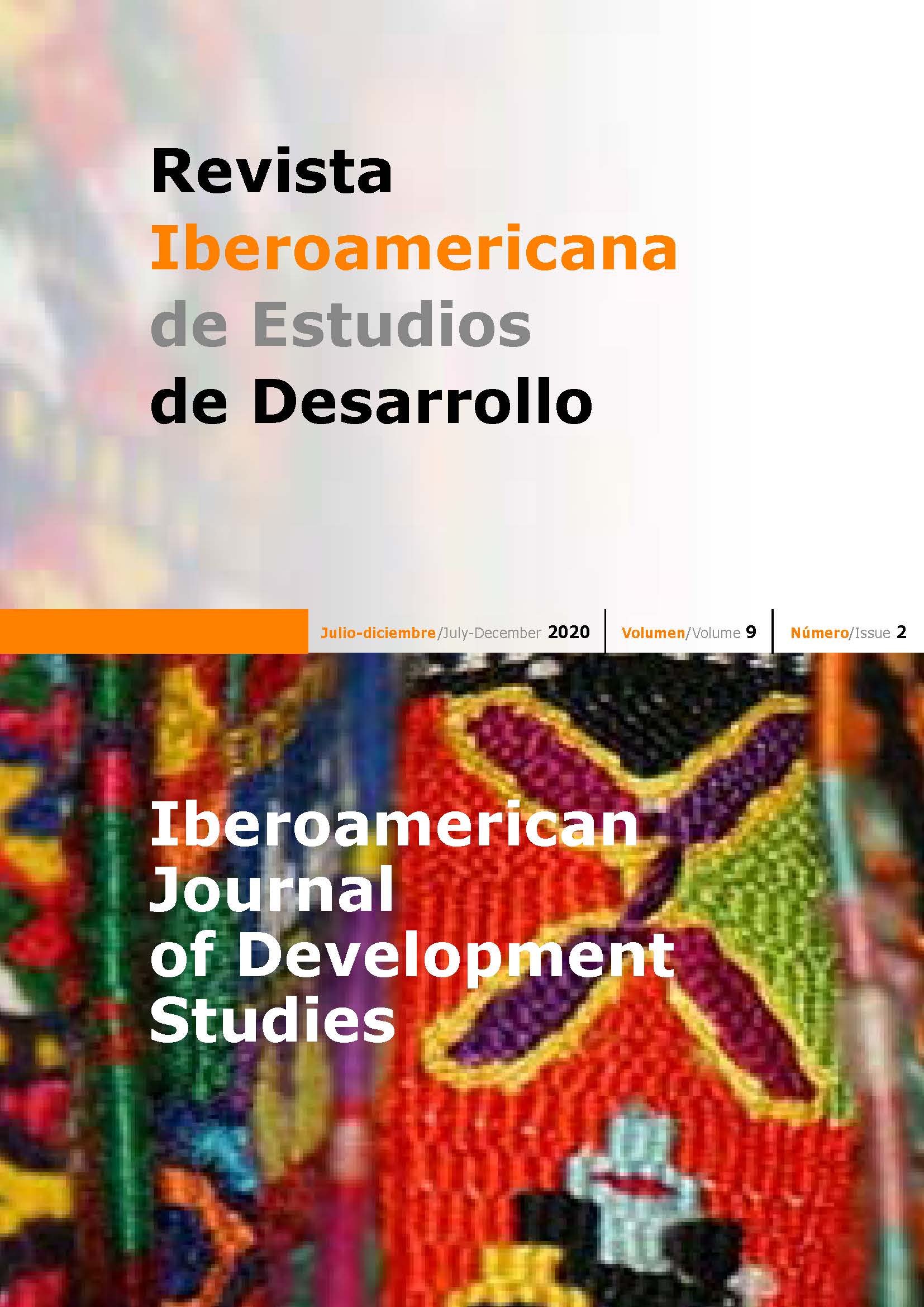Los orígenes de la vulnerabilidad macroeconómica y sus principales efectos: propuesta de un marco teórico
DOI:
https://doi.org/10.26754/ojs_ried/ijds.474Palabras clave:
vulnerabilidad macroeconómica, shocks externos, economías en desarrollo, política macroeconómicaResumen
El objetivo de este estudio es presentar una propuesta sistemática que permita entender el concepto de vulnerabilidad macroeconómica (VM), las fuentes que la generan y los mecanismos a través de los cuales transmite sus efectos hacia los principales agregados macroeconómicos; particularmente, en las economías en desarrollo. Así, a diferencia de otros estudios que se han enfocado en los efectos que generan los shocks externos sobre los mercados financieros, dentro de esta investigación lo que se busca es ahondar en el impacto causado por estos desde la perspectiva de la economía real. Dentro de este ejercicio, se sistematizan las principales contribuciones provenientes del neoestructuralismo, donde, a pesar de no haber una propuesta formal de VM, se encontró que existen una serie de elementos a partir de los cuales se puede configurar un marco de análisis que permite entender la dinámica económica de este tipo de países.
Descargas
Citas
ABELES M, VALDECANTOS S (2016). Vulnerabilidad externa en América Latina y el Caribe. Un análisis estructural. Serie Estudios y Perspectivas 49. Cepal, Buenos Aires.
ANGEON V, BATES S (2015). Reviewing composite vulnerability and resilience indexes: a sustainable approach and application. World Development 72:140-162.
ATKINS J, MAZZI S, RAMLOGAN C (1998). A study of the vulnerability of developing and island states: a composite index. Commonwealth Secretariat, Londres.
BARITTO F (2009). Disasters, vulnerability and resilience from a macro-economic perspective. Lessons from the empirical evidence. Background paper for the 2009 ISDR Global Assessment Report on Disaster Risk Reduction. https://www.preventionweb.net/english/hyogo/gar/background-papers/documents/Chap2/Baritto-Macroeconomic-Report.pdf , acceso 17 de diciembre de 2017.
BATES S, ANGEON V, AINOUCHE A (2014). The pentagon of vulnerability and resilience: A methodological proposal in development economics by using graph theory. Economic Modelling 42:445-453.
BIELSCHOWSKY R, IZAM M, MULDER N (2011). Dos estudios de la evolución del pensamiento de la Cepal sobre la diversificación productiva y la inserción internacional (1949-2008). Series Comercio Internacional 12, Santiago de Chile.
BLANCHARD O, GALÍ J (2007). Real wage rigidities and the New Keynesian model. Journal of Money, Credit and Banking 39(s1):35-65.
BLANCHARD O, DELL’ARICCIA G, MAURO P (2010). Rethinking macroeconomic policy. IMF Staff Position Note. International Monetary Fund, Washington.
BRIGUGLIO L (1995). Small island developing states and their economic vulnerabilities. World Development 23(9):1615-1632.
BRIGUGLIO L (2003). The vulnerability index and Small Island Developing States: A review of conceptual and methodological issues. En: AIMS Regional Preparpaatory Meeting on the Ten Year Review of the Barbados Programme of Action. Praia, Cabo Verde.
BRIGUGLIO L (2014). A vulnerability and resilience framework for small states. En: Bynoe-Lewis D (ed.). Building the Resilience of Small States: A Revised Framework. London Commonwealth Secretariat.
BRIGUGLIO L, CORDINA G, FARRUGIA N, VELLA S (2009). Economic vulnerability and resilience: concepts and measurements. Oxford Development Studies 37(3):229-247.
BUSSO G (2001). Vulnerabilidad social: nociones e implicancias de políticas para Latinoamérica a inicios del siglo XXI. Seminario internacional las diferentes expresiones de la vulnerabilidad social en América Latina y el Caribe, 20-21/06/2001. Cepal, Santiago de Chile.
CEPAL (2001). Crecer con estabilidad: el financiamiento del desarrollo en el nuevo contexto internacional. Ocampo JA (coord.). Cepal, Alfaomega, Santafé de Bogotá.
CEPAL (2004). América Latina y el Caribe en la era global. Publicación de las Naciones Unidas. Alfaomega, Bogotá.
CEPAL (2010). La hora de la igualdad: brechas por cerrar, caminos por abrir. Trigésimo tercer período de sesiones de la Cepal. Brasilia/Santiago de Chile.
CHAMBERS R (1989). Vulnerability: how the poor cope. IDS Bulletin 20(2). Institute of Development Studies, University of Sussex, Brighton (Gran Bretaña).
CORDEN W, NEARY J (1982). Booming sector and de-industrialitation in a small open economy. The Economic Journal [e-journal] 92(368):825-848.
CORDERO J, MONTECINO J (2010). Capital Controls and Monetary Policy in Developing Countries. Center for Economic and Policy Research, Washington, DC.
CORDINA G (2004). Economic vulnerability and economic growth: some results from a neo-classical growth modelling approach. Journal of Economic Development 29(2):21-39.
EDWARDS S, CAVALLO DF, FRAGA A, FRENKEL J (2003). Exchange rate regimes. En: Economic and Financial Crises in Emerging Market Economies. University of Chicago Press, pp. 31-92.
EICHENGREEN B (2007). The real exchange rate and economic growth. Social and Economic Studies 56(4):7-22.
EPSTEIN G (2002). Employment-Oriented Central Bank Policy in an Integrated World Economy: A Reform Proposal for South Africa. Working Paper, 39. Political Economy Research Institute, University of Massachusetts, Amherst.
EPSTEIN G, YELDAN E (2009). Beyond inflation targeting: assessing the impacts and policy alternatives. En: Epstein G, Yeldan E (eds.). Beyond Inflation Targeting: Assessing the Impacts and Policy Alternatives. Northampton (Massachusetts), pp. 3-27.
FFRENCH-DAVIS R (1996). Políticas macroeconómicas para el crecimiento. Revista de la Cepal 60.
FFRENCH-DAVIS R (ed.) (2005). Crecimiento esquivo y volatilidad financiera. Cepal, Mayol Ediciones, Bogotá.
FFRENCH-DAVIS R (2008). From financieristic to real macroeconomics: Seeking development convergence in emerging economies. Working Paper 44. Commission on Growth and Development, World Bank, Washington.
FFRENCH-DAVIS R (2010). Macroeconomía para el desarrollo: desde el financierismo al productivismo. Revista de la Cepal 102:7-27.
FFRENCH‐DAVIS R (2012). Empleo y estabilidad macroeconómica real: el rol regresivo de los flujos financieros en América Latina. Revista Internacional del Trabajo 131(1‐2):23-46.
FFRENCH-DAVIS R (2015). Neoestructuralismo y macroeconomía para el desarrollo. En: Bárcena A, Prado A (eds.). Neoestructuralismo y corrientes heterodoxas en América Latina y el Caribe a inicios del siglo XXI. Cepal, Santiago de Chile, pp. 119-143.
FFRENCH-DAVIS R, OCAMPO JA (2001). Globalización de la volatilidad financiera: desafíos para las economías emergentes. En: Ffrench-Davis R (comp.). Crisis financieras en países exitosos. Cepal, Santiago de Chile: McGraw-Hill/Interamericana de Chile LTDA, pp. 1-41.
FISCHER S (1993). The role of macroeconomic factors in growth. Journal of Monetary Economics 32(3):485-512.
FMI [FONDO MONETARIO INTERNACIONAL] (1998). Financial crises: characteristics and indicators of vulnerability. En: FMI (ed.). World Economic Outlook, Washington, capítulo IV, pp. 74-97.
FRENKEL R, TAYLOR L (2006). Real Exchange Rate, Monetary Policy and Employment: economic development in a garden of forking paths. Working Paper, 19, Undesa. United Nations, Nueva York.
GHOSH SR, GHOSH AR (2003). Structural vulnerabilities and currency crises. IMF Economic Review 50(3):481-506.
GUILLAUMONT P (2010). Assessing the economic vulnerability of small island developing states and the least developed countries. The Journal of Development Studies 46(5):828-854.
GUILLAUMONT P (2013). Measuring structural vulnerability to allocate development assistance and adaptation resources. Development Policies Working Paper 68.
GUILLAUMONT P (2016). Vulnerability and resilience: a conceptual framework applied to three Asian countries Bhutan, Maldives and Nepal. ADB South Asia Working Paper Series 53, Asian Development Bank.
IZQUIERDO A, ROMERO-AGUILAR R, TALVI E (2008). Booms and busts in Latin America: the role of external factors. Working Paper 631, Inter-American Development Bank, Research Department, Washington DC.
JIMÉNEZ J, FANELLI J (comps.) (2009). Crisis, volatilidad, ciclo y política fiscal en América Latina. Cepal, Santiago de Chile.
KAMINSKY G, LIZONDO S, REINHART CM (1998). Leading indicators of currency crises. Staff Papers ‒ International Monetary Fund 45(1):1-48.
KAMINSKY GL, REINHART CM, VÉGH CA (2004). When it rains, it pours: procyclical capital flows and macroeconomic policies. NBER Macroeconomics Annual 19:11-53.
KRUGMAN P (1987). The narrow moving band, the Dutch disease, and the competitive consequences of Mrs. Thatcher: notes on trade in the presence of dynamic scale economies. Journal of Development Economics 27:41-55.
KRUGMAN P, TAYLOR L (1978). Contractionary effects of devaluation. Journal of International Economics 8(3):445-456.
KUWAYAMA M, DURÁN J (2003). La calidad de la inserción internacional de América Latina y el Caribe en el comercio mundial. Serie Comercio Internacional 26, Cepal.
LOAYZA NV, RADDATZ C (2007). The structural determinants of external vulnerability. The World Bank Economic Review 21(3):359-387.
MONTALBANO P (2011). Trade openness and developing countries vulnerability: concepts, misconceptions, and directions for research. World Development 39(9):1489-1502.
MOSER C (1998). The asset vulnerability framework: reassessing urban poverty reduction strategies. World development 26(1):1-19.
OCAMPO JA (2002). Developing countries anti-cyclical policies in a globalized world. En: Dutt A, Ros J (eds.). Development Economics and Structuralist Macroeconomics: Essays in Honor of Lance Taylor. Edward Elgar, Aldershot.
OCAMPO JA (2005). Los caminos para superar las frustraciones de crecimiento en América Latina. En: Ffrench-Davis R (ed.). Crecimiento esquivo y volatilidad financiera. Mayol Ediciones, Santiago de Chile, pp. 31-56.
OCAMPO JA (2007). Una visión amplia de la estabilidad macroeconómica. Revista de Economía Política de Buenos Aires 1:7-30.
OCAMPO JA (2008). Macroeconomic vulnerability and reform: managing pro-cyclical capital flows. Paper presented at the international symposium «Financial Globalization and Emerging Market Economies». Bangkok, Bank of Thailand.
OCAMPO JA (2011). Macroeconomía para el desarrollo: políticas anticíclicas y transformación productiva. Revista de la Cepal 104:13-41.
OCAMPO JA (2012). Balance of payments dominance: Its implications for macroeconomic policy. School of International and Public Affairs, Columbia University, unpublished paper.
OMC (2010). Informe sobre el comercio mundial 2010. El comercio de los recursos naturales.
OMC (2013). Informe sobre el comercio mundial 2013. Factores que determinan el futuro del comercio.
PALMA G (1998). There and a half cycles of mania, panic and [asymmetric] crash: East Asia and Latin America compared. Cambridge Journal of Economics 22(6):789-808.
PÉREZ E (2015). Una coyuntura propicia para reflexionar sobre los espacios para el debate y el diálogo entre el (neo)estructuralismo y las corrientes heterodoxas. En: Bárcena A, Prado A (eds.). Neoestructuralismo y corrientes heterodoxas en América Latina y el Caribe a inicios del siglo XXI. Cepal, Santiago de Chile, pp. 33-91.
PINEDA R, CÁRCAMO-DÍAZ R (2013). Política monetaria, cambiaria y macroprudencial para el desarrollo, volatilidad y crecimiento en América Latina y el Caribe, 1980-2011. Serie Macroeconomía del Desarrollo 142, Cepal.
RAMEY G, RAMEY V (1995). Cross-country evidence on the links between volatility and growth. The American Economic Review 85:1138-1151.
RODRIK D (1998). Who needs capital account convertibility? En: Stanley Fischer et al. (ed). Should the IMF pursue capital-account convertibility? Princeton Essays in International Finance, Princeton, pp. 55-65.
RODRIK D (2001). ¿Por qué hay tanta inseguridad en América Latina? Revista de la Cepal 73:7-31.
SACHS JD, WARNER AM (1995). Natural resource abundance and economic growth. NBER Working Paper 5398.
SETH A, RAGAB A (2012). Macroeconomic vulnerability in developing countries: Approaches and issues. International Policy Centre for Inclusive Growth. Working Paper 94:1-20.
STIGLITZ JE (2000). Capital market liberalization, economic growth, and instability. World Development 28(6):1075-1086.
TAYLOR JB (1993). Discretion versus policy rules in practice. Carnegie-Rochester Conference Series on Public Policy 39:195-214.
THIRLWALL AP (1979). The balance of payments constraint as an explanation of international growth rates differences. Banca Nazionale del Lavoro Quarterly Review 128:45-53.
THIRLWALL AP (2011). The balance of payments constraint as an explanation of international growth rate differences. Banca Nazionale del Lavoro Quarterly Review 429-438.
TITELMAN D, PÉREZ E (2015). Macroeconomía para el desarrollo en América Latina y el Caribe: nuevas consideraciones sobre las políticas anticíclicas. En: Bárcena A, Prado A (eds.). Neoestructuralismo y corrientes heterodoxas en América Latina y el Caribe a inicios del siglo XXI. Cepal, Santiago de Chile, pp. 155-184.
VALDECANTOS S (2016). Estructura productiva y vulnerabilidad externa: un modelo estructuralista stock-flujo consistente. Serie Estudios y Perspectivas. Cepal 46, Buenos Aires.
VILLAGRÁN JC (2006). Vulnerability: A Conceptual and Methodological Review. Studies of the University Research Counsel Education. Bonn.
Descargas
Publicado
Cómo citar
Número
Sección
Licencia
Derechos de autor 2020 Luis Hernando Portillo-Riascos

Esta obra está bajo una licencia internacional Creative Commons Atribución-NoComercial-SinDerivadas 4.0.






